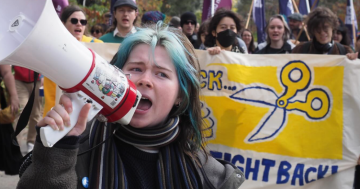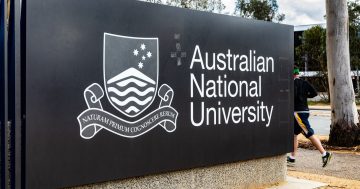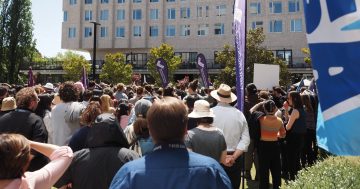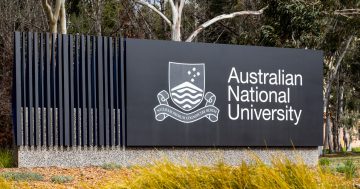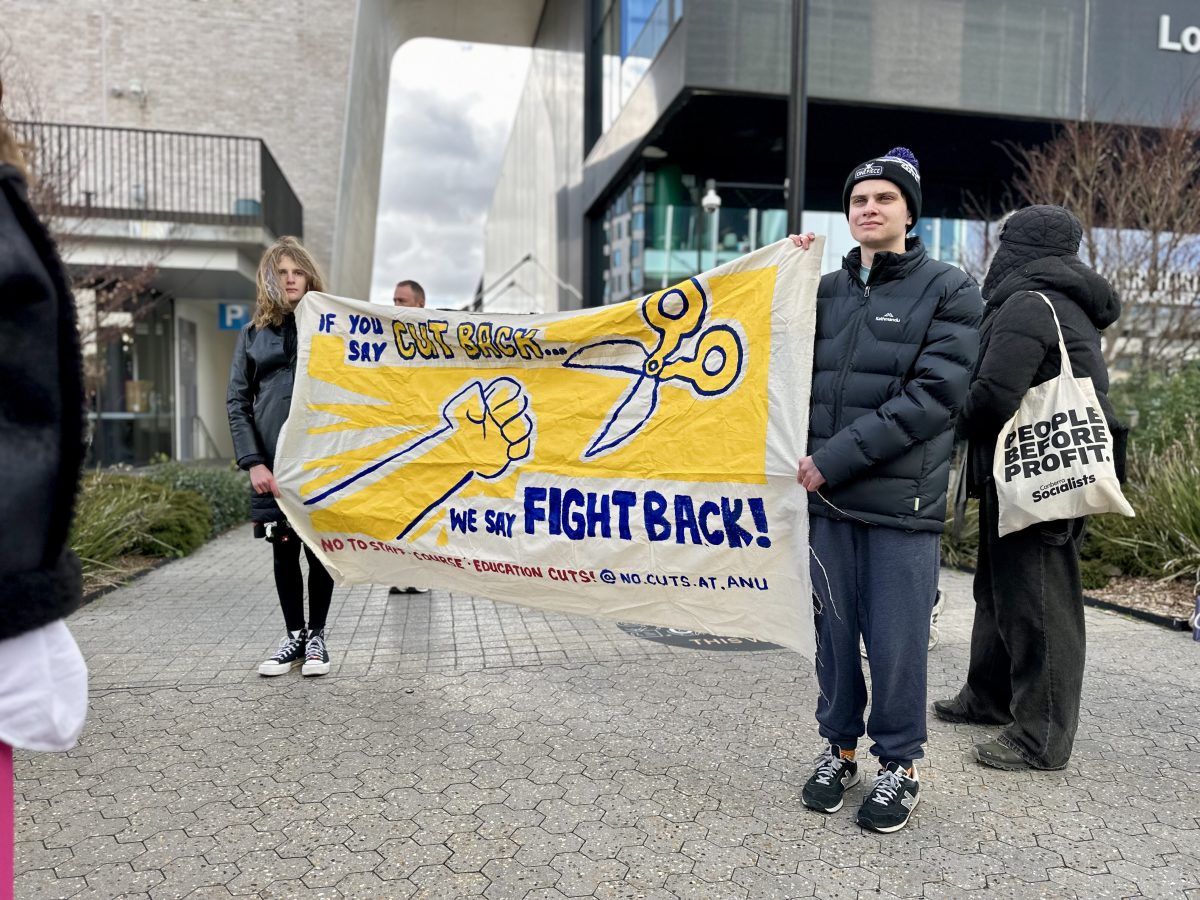
The Renew ANU process has been repeatedly slammed at campus protests. Photo: James Coleman.
The Australian National University has insisted that staff and student safety won’t be compromised by proposed changes to the Campus Environment division.
The latest change management plan (CMP) puts 16 occupied roles on the chopping block. Another eight vacant positions will be “disestablished”, along with 10 positions already vacated through the voluntary separation scheme (VSS) process. 18 new positions have been proposed.
According to the proposal, the VSS initiative will result in an estimated annual salary saving of $1,400,308.19, while the reduction in vacant and occupied staff positions will deliver a further $1,129,597.44 in salary and “on-costs”.
The division had previously been targeted in October 2024, which delivered annualised savings of $1.52 million, including $1.18 million in salary savings.
According to the CMP document, this latest stage was proposed to “address current deficiencies in contract management expertise” and increase efficiency through a “streamlined structure that enhances contract management and will result in improved service delivery”.
Chief Campus Environment Officer Jeremy Matthew told staff this next CMP would disestablish the Infrastructure and Planning, and Corporate portfolios, and expand the Operations portfolio (to include capital works, procurement, contract management and WHS).
“What we’re proposing here is a much more refined, simplified structure, clearly delineating between delivery functions and planning, strategy and revenue functions,” he said.
“We’re still going to need to cross-collaborate, we’ll never get away from that in our division, but I feel that the proposal that we’ve put forward will strengthen those connections.”
Under the proposal, building maintenance, landscape and conservation, WHS, and remote sites roles will be realigned into a new Assets and Maintenance Team within Operations.
Mr Matthew said the new team was off the back of about four years’ work to reduce the number of contracts for delivery services.
“What we’re proposing in here … [as] it’s always been a vendor-based setup, is to strengthen the contract management capability within that team,” he said.
A new Commercial, Planning and Strategy Portfolio would bring together environmental sustainability, engineering, estate systems and space planning, and revenue teams.
The currently closed University House would remain unchanged for now as a business case is currently being developed for its future operating model.
Among the jobs “at risk of being declared surplus” are the occupied SM2 security manager, three 05 UniSafe administration assistants and control officers, and the 06/07 WHS HAZMAT officer.
The ANU does have a contract with security provider MSS (valued at about $4.3 million per year) for 24/7 security services.
Chief Operating Officer Jonathan Churchill sent an email to all staff after the CMP was released.
“[This proposal contains changes to] operations group, including facilities colleagues currently working in colleges joining the CE Division, and completing the consolidation of the division’s organisational structure,” he said.
“The university can absolutely confirm that this change proposal will not impact student and staff safety at the university.”
NTEU ACT branch president Millan Pintos-Lopez said the ANU wasn’t just responsible for the physical safety of staff, who were already “overworked and undervalued”.
“[This proposal] relies heavily on ‘spill and fill’ change management, forcing colleagues to compete against each other for their livelihoods,” he said.
“This approach to change has long-term impacts on the workplace culture and mental well-being of staff, well beyond the change.
“In light of the recent Senate inquiry, it’s yet another example of poor executive leadership that the first all-staff email since [the hearings] is announcing further job cuts.”
National Tertiary Education Union (NTEU) division secretary Dr Lachlan Clohesy added: “The jobs that should be going are those of the Chancellor and Vice Chancellor.”
The latest news comes days after ACT independent Senator David Pocock called for Chancellor Julie Bishop to stand aside, and for his ACT Labor colleagues to do more.
ACT Labor Senator Katy Gallagher told the ABC she had been having a number of meetings with both ANU executives and concerned parties and that she was doing everything she “should be doing as a Senator”.
“I choose not to play that out in the media, because I’m choosing to try and get outcomes on this,” she said.
“I think there are significant problems with the way that Renew ANU is going, and I’ve raised those directly with the Vice Chancellor, and I’ve raised them directly with the [Federal Education] Minister, as have all of my federal colleagues … Governments have to be very careful about how they involve themselves in interfering with universities, and there’s been a lot of good reasons why that’s the case.
“I’m not going to call for anyone’s head right now, which is what some people want, whether it’s the Chancellor or the Vice Chancellor.”
Senator Gallagher did say she felt the Vice Chancellor and her executive needed to think about how the Renew ANU process was being undertaken, and that the Chancellor had to respond to the issues raised.
Feedback on the Campus Environment CMP is open until 28 August, with an implementation plan expected by 18 September.












